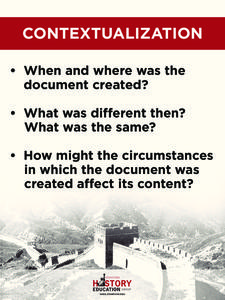Stanford University
Letter from Birmingham Jail: The Power of Nonviolent Direct Action
What strategies are most effective in changing an unjust law? Class members examine the tactics used in the Birmingham Campaign of 1963 (Project C) to achieve social justice and social transformation. After examining documents that...
Stanford University
Lesson Plan: Montgomery Bus Boycott
Most of us have heard of Rosa Parks, the Montgomery Bus Boycott, and Martin Luther King, Jr. But what about Claudette Colvin, Virginia Durr, Freedom Summer, or the Birmingham Children's Crusade? A five-lesson unit prompts class...
Stanford University
Beyond Vietnam
On April 4, 1967 Martin Luther King, Jr. delivered his speech "Beyond Vietnam." The controversy that followed is the focus of a three-instructional activity unit that asks class members to consider the political and social implications...
Stanford University
Martin Luther King, Jr. and Malcolm X: A Common Solution?
Much has been made of the differences between Martin Luther King, Jr. and Malcolm X. But was there any common ground between them? Class members reconsider what they think they know about these two civil rights leaders with...
Stanford University
Voices of the Struggle: The Continual Struggle for Equality
As part of a study of the Civil Rights Movement from 1868 to the present, class members examine first person narratives, the Supreme Court case Brown v. Board of Education, and other significant events in civil rights history....
Stanford University
Solstice and Equinox Season Model
How can December 21 be the shortest day of the year when all days are 24 hours long? Pupils see how to build a model showing the differences between winter and summer solstices and equinoxes. Using this model, classes can then discuss...
Stanford University
Corroboration
How do historians corroborate the information in a primary source document? They use the questions features on this poster!
Stanford University
Contextualization
Part of a series of posters designed to be used with a unit fostering the skills needed to read like a historian, this template models the questions researchers need to ask to contextualize a primary source document.
Stanford University
Sourcing
What questions do historians ask when sourcing a document? Here's a poster that models these questions.
Stanford University
Close Reading
Here's a poster that highlights the skills needed for the close reading of primary source documents when gathering evidence to support historical claims.
Stanford University
What Is History?
Five important tenets of any social studies class are available for young historians with a poster that defines history as an account of the past. It encourages learners to question reliability of an author's perspective, as well as...
Stanford University
Historical Thinking Chart
Narrow down your questions about author perspective, historical context, and veracity of claims in a document with the help of a historical reading chart. Learners track the basics of the document along with advanced evaluation skills...
Stanford University
King Philip's War
King Philip's War was the crescendo of a violent period between the Pequot and English colonists. Using documents from English settlers, including a contemporary report on the conflict, learners explore the little-known period. They then...
Stanford University
Boston Massacre
The Boston Massacre was a propaganda victory for those protesting British rule over the American colonies. By using images from Patriots, as well as the testimony of witnesses, scholars consider what may have happened on that fateful day...
Stanford University
Philippine-American War Political Cartoon
Students investigate the Philippine War. In this propaganda lesson, students read the a timeline of events during the Philippine War. Students evaluate Philippine propaganda cartoons from the period.
Stanford University
Chicago Race Riots of 1919
Students explore the Chicago Race Riots of 1919. In this American history lesson, students watch the move "Up South" regarding the African American migration following World War I. Students read primary documents regarding the race riots...
Stanford University
The 1898 North Carolina Election
Pupils discuss why the Democrats defeated the Fusion ticket in the 1898 North Carolina election. In this content area reading instructional activity, learners explore three primary documents and answer guiding questions that help them...
Stanford University
Scopes Trial
Students review information about religious movements in the United States. In this Butler Act lesson, students view a video and read in their textbook about the Butler Act. Students review documents about the Scopes trial and...
Stanford University
Reconstruction Structured Academic Controversy (SAC)
Young scholars debate whether African Americans were free during Reconstruction. In this debate instructional activity, students use primary documents to support their argument as to whether African American were free during the...
Stanford University
Settlement House Movement SAC
Students read and view a movie on Social Gospel and Settlement Houses. In this Social Reform lesson plan, students view the movie, read the passages and answer questions on the social reform movement of this time.
Stanford University
New Deal SAC
Students explore the New Deal. In this U.S. history instructional activity, students read and analyze several documents related to the New Deal. Students form two teams and decide whether the New Deal was a success or a...
Stanford University
Gulf of Tonkin Resolution
Students read, discuss, and view a Powerpoint on the Gulf of Tonkin Resolution. In this Gulf of Tonkin Resolution lesson plan, students research the resolution and then answer short answer questions about it.
Stanford University
Political Bosses Lesson Plan
Students research the political bosses and the political machine in New York City. In this politics lesson, students review the term progressives, political bosses, and political machine. Students study a Tammany cartoon and read...
Stanford University
Sedition in World War I
Students examine the critics of the First World War. In World War I lesson, students free write about patriotism and determine its meaning. After watching a video students discuss patriotism and opposition to the war. Students...

























